Hurricane Season June 1- November 30
Will You Be Ready?


Hurricane Season June 1- November 30
Will You Be Ready?

The City’s Mission Statement is “Responsive government focused on safety, service, and sustainability.” HURRICANE READY is a program developed with that mission in mind. It is designed to aide beach residents, visitors and businesses in being prepared and resilient to the impact of tropical weather events.

The official start of hurricane season is June 1st . Over the last eight years, with the exception of 2021,a named storm has formed before the official start of hurricane season. Last year, Tropical Storm Alex developed in the Gulf of Mexico on May 25th , but was not named until June 5th after it crossed Florida and intensified in the Atlantic. Since 2016 there has been above-average storm activity in the Atlantic basin Due to the trend of tropical storm development earlier than June, we should prepare earlier also. The information in this guide is meant to assist the community in that preparation.
This guide consists of 4 parts:
1. Individual Readiness.
2. Business Readiness.
3. Structure Readiness.
4. Resources.
Inside this guide are checklist, worksheets, and information to assist with preparedness and the hardening of structures
STORM SURGEis the greatest threat to life and property. It is an abnormal rise of water generated by a hurricane. Storm surge can travel several miles inland, especially along the coast, Intracoastal Waterway, and other tributaries. Heights of the surge can reach well over 15 feet.
FLOODING is a major threat during a hurricane or tropical storm. Whether you live on the coast or inland, hurricanes and tropical storms can produce widespread torrential rain that may result in deadly and destructive floods.
TORNADOEScan be produced by hurricanes and tropical storms. Usually, these tornadoes are relatively weak and short-lived, but they pose a significant threat to life and property.
STRONG WINDS are created that can reach speeds over 150 miles per hour creating catastrophic destruction that includes roof and wall failure of wood framed houses.
Tropical Storm or Hurricane conditions are possible within 48 hours. Monitor alerts and prepare for evacuation.

Tropical Storm or Hurricane conditions are possible within 36 hours. Complete preparations and evacuate if directed
EVACUATION ZONE designations for the beach communities are Zones
A and B. Due to the beach communities being on a barrier island when an evacuation order is issued, both zones will need to evacuate. Evacuation routes will be open until the wind speed on the bridges reaches 39 mph. At that time, the Sheriff’s Office will shut down the bridges.
EVACUATION ORDERS will be issued by the beaches Mayors in conjunction with the Mayor of Jacksonville when there is an imminent threat to life. This order may be issued up to 96 hours prior to landfall.
EVACUATION ASSISTANCE with transportation is available through the Jacksonville Transportation Authority (JTA). When an evacuation order is issued, residents can go to any bus stop and board the bus marked “Evacuation Shuttle”. The buses will transport individuals to transfer hubs where they will change buses to be transported to designated public shelters. Jacksonville Beach Elementary, Fletcher High School, and Mayport Middle School are the bus transfer hubs located in the beach communities.
All fees will be waived to board the buses. This service will stop as weather conditions deteriorate.
EVACUATION ACTIONS include turning off natural gas and propane tanks, electricity at the electric panel by flipping main breaker to the “off” position, and shutting off the main water valve where it comes into the house.
It is recommended to take pictures or videos of your residence to assist in documentation for any potential insurance claims.
EVACUATION SHELTERS are operated by the American Red Cross. If an evacuation order is issued for your neighborhood, you should shelter with family, friends, or in a hotel. Evacuation Shelters are areas of last resort and should only be considered if there are noother options. You will need to bring your own food, pillow, and bedding to the shelter. ALCOHOL and SMOKING are not permitted at any shelter, nor is childcare provided. Shelter locations are announced prior to their opening and can be found on https://www.jaxready.com/.
1. General Population Shelters. Managed by the American Red Cross and are filled on a first come basis.
2. Pet Friendly Shelters. Provide shelter to evacuees and their household pets including dogs, cats, birds, and rabbits. Kennels are required for all pets and they will be sheltered in a separate location within the shelter. Evacuees need to bring their personal supplies along with pet food and water, shot records, and any medicine the pet requires.
3. Special Needs Shelters. A Special Needs Shelter has backup power and is capable of providing refuge for individuals who have health conditions that require basic assistance or supervision from a medical professional. These shelters are managed by the Florida Dept. of Health. A caregiver is required to accompany any individual requiring more than basic assistance. Evacuees are required to bring their personal medical supplies and dietary needs. You must PREREGISTER every year if you plan to stay at a special needs shelter. Registration can be completed on line at coj.net/specialmedicalneeds or call 904-630-CITY (2489). Also provided in this guide is a printed version that can be filled out for registration and mailed or faxed into the address provided on the form.
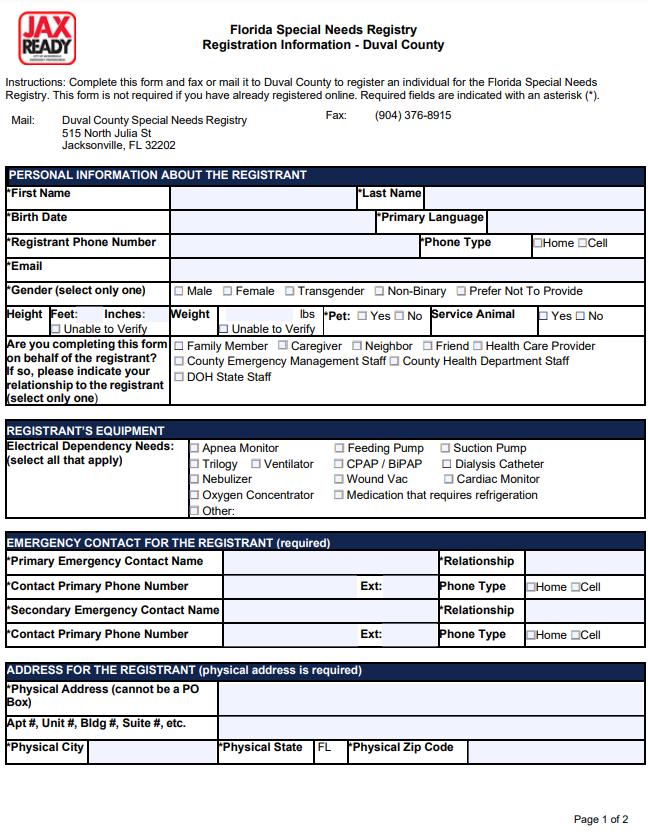

Every individual needs to have an EMERGENCY PLAN which provides for family readiness in the event of an emergency The plan needs to:
Identify the location that you will evacuate to.
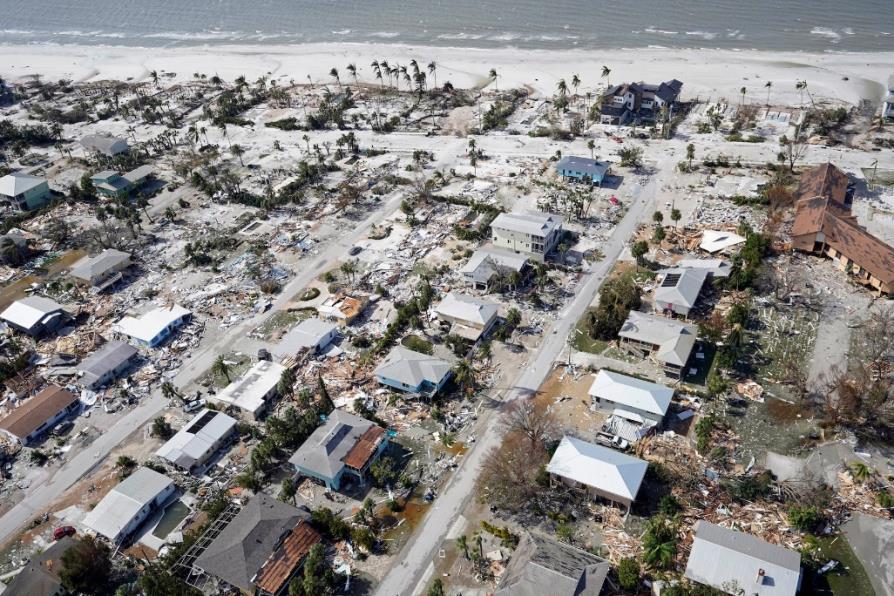
Prepare emergency/evacuation supply kit with three to seven days of supplies for all family members.
Have an update contact list of family, friends, and services.
Identify who will be primary contact for all family members to check in with and report their status.
Identify alternative communication systems available
Be an entire household plan that includes children and pets.
Be shared with friends, co-workers, and out-of-town family members
Being prepared means having your own EMERGENCY SUPPLY GO KIT that will last a minimum of three to seven days and should contain:
Non-perishable snacks and packaged or canned food.
Manual can opener.
Clothing, rain gear, and sturdy shoes.
Bedding for a small space.
Prescription medications.
Personal hygiene items.
Toilet paper.
Special items such as food for infants and other necessary items for elderly or disabled family members.
First-aid kit.
At least one gallon of water per person, per day
Fully charged portable electronic devices with chargers.
Quiet games, toys, or reading materials.
Eyeglasses, contact lenses, hearing aids with extra batteries.
Pet care items, vaccination records, food, and water.
Flashlight, battery-powered radio, and batteries
Extra set of car keys.
Cash
Important documents in a waterproof container or bag.
When returning home, you must think safety first:
Avoid downed, damaged or loose power lines and report them immediately to Beaches Energy at (904)247-6171 or 911.
When power returns do not start all major appliances at once. Turn them on gradually to reduce damage to sensitive equipment.
NEVER use a generator indoors. This includes garages and crawlspaces. Exhaust fumes contain high levels of carbon monoxide, which can be deadly if inhaled, even when left outside.
Keep generators away from doors and windows and at least 10 feet away from your home.
Allow your generator to cool off before refilling it with gas – splashing gas on hot generator components can lead to a fire.
Do Not use electrical or gas appliances that have been wet due to chance of an electric shock or fire occurring
Do Not use charcoal indoors due to the high levels of carbon monoxide that is produced.
Follow post-storm food and water safety precautions to protect your family from contamination.
Stay away from flood waters as they can contain harmful contaminants, hide dangerous debris and animals.
Take photographs of any damage incurred.
If flooding or water damage has occurred begin cleaning up and making repairs as soon as possible to avoid mold.
Hurricane season runs from June 1st through November 30th. The chances of hurricanes forming are the greatest between August 15th and October
1st The odds of you visiting during a hurricane are low
Tropical weather events are classified in three categories:
1. TROPICAL DEPRESSIONS have surface winds of 38mph or less that last at least 1 minute.
2. TROPICAL STORMS have sustained winds ranging from 39-73mph.
3. HURRICANES have sustained winds of 74mph or greater.
The National Weather Service will issue Watches and Warnings alerting the public of any impending storms.
1. TROPICAL STORM WATCH is issued when Tropical Storm conditions pose a POSSIBLE threat within 48 hours.
2. TROPICAL STORM WARNING is issued when Tropical Storm conditions are EXPECTED within 36 hours or less.
3. HURRICANE WATCH is issued when sustained winds of 74mph or higher are POSSIBLE. Because hurricane preparedness activities become difficult once winds reach tropical storm force, the Watch is issued 48 hours in advance of tropical storm force winds.
4. HURRICANE WARNING is issued when sustained winds of 74mph or higher are EXPECTED. The Warning is issued 36 hours in advance of tropical storm force winds.
It is important you have an idea of what to do if a Watch or Warning is issued. Below is a list of preparedness actions:
1. Keep an eye on the weather. Advancing tropical weather events are reported across all media types well in advance of there arrival. The tropical weather forecast can be checked at the National Hurricane Center website https://www.nhc.noaa.gov/.
2. Evaluate how safe your location is. Most deaths from tropical events are from raising water. Storm surge from tropical events can be 20 feet or higher covering the entire beach community. Does your rental unit appear to be a converted shed? If it is under 600 sq ft. it was most likely not built to withstand tropical winds.
3. Comply with evacuation orders. Mandatory evacuation orders may be issued up to 96 hours prior the arrival of tropical storm force winds. Bridges off the island will be CLOSED when wind speeds are sustained at 39 mph.
4. Ensure you have plenty of cash on hand.
5. Do not rely solely on the supplies in the rental unit You should have 3-5 days of food, water, and medicine on hand for each family member and pets. Anticipate there will not be electricity for a week or longer.
6. Have a battery powered radio.
7. Charge all your electronics before the storm
8. Ensure family and friends know the exact location you’re staying prior to the storm.
9. Understand comfort is the last thing you should expect
10. Be prepared to have your stay extended due to damage roadways, bridges, or disruption in transportation services.
To aid in the safety of employees and customers, businesses need to have Emergency Preparedness Plans. These plans not only need to address the needs of the business, but also must take in consideration the needs of employees. These needs include: time off to make preparation for their families and homes, along with knowing they will receive their paychecks on time.
A Business Continuity Plan needs to be part of a company’s emergency preparedness. A Business Continuity Plan (BCP) refers to a company’s procedures to restore critical business functions in the event of a disaster. Having this BCP will allow a company to resume operations with minimal disruption.
The following questions need to be answered in the development of the BCP:
How would the organization function if desktops, laptops, servers, email, and internet access were unavailable?
What single points of failure exist?
What risk controls and risk management systems are in place?
What are the critical outsourced relationships and dependencies?
During a disruption, what workarounds are there for key business processes and internal functions, such as human resources?
What is the minimum number of staff needed to run operations, and what functions would they need to carry out?
What are the key skills and knowledge needed to recover?
What critical security or operational controls are needed if computer systems are down?

ROOF. Ensure the roof is in good condition. The roof cover is the most valuable component. It should be inspected annually, checking for loose or missing shingles, tears, bubbles, cracks, pooling water, and debris buildup. While inspecting the roof the following items need to be inspected:
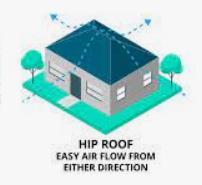
1. Shingles Loose shingles should be re-nailed or replaced.
2. Perimeter Flashing. Check the roof flashing to ensure it is not loose or missing. Flashing prevents the wind from getting under the roof lining, which can cause the roof cover to be peeled off.
3. Roof Mounted Equipment. Ensure all equipment is securely attached, flashing around the equipment is not loose, and all service panel fasteners are in place. Remove any debris buildup.
4. Skylights. Check skylights for leaks and cracks.
5. Lightning Protection If your building has lightning protection, the connectors need to be checked to ensure the system is still secured to the building. This can be performed by giving a gentle tug to the securements and conductor poles.
When constructing a building, the Hip Roof design offers the best protection during high winds.
DOORS. Doors damaged by wind or debris can lead to costly interior damage and roof damage. Ensure door frames and all door hinges are securely attached and not missing any screws. Examine door panels for dents and protect any non-hurricane rated doors that have glass panes. Protection measures include: Fabric, panels, shutters, and plywood.

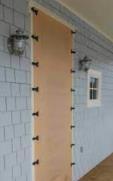


Sand bags or dam/diking material can be used to protect door openings from flood waters. While the City does not provide sand bags, residents can go to any hardware store to acquire the needed material. DO NOT TAKE SAND FROM THE BEACH.
Sand Bagging Procedures:
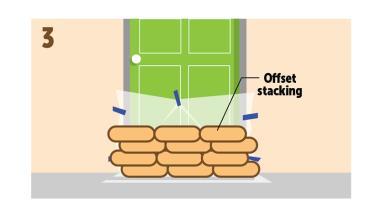
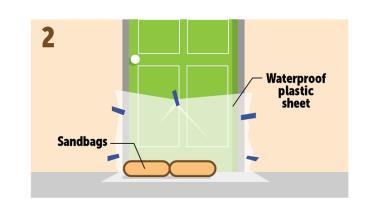

WINDOWS. Keeping wind and water out is key to survival during a hurricane. All windows and the glass in doors should be protected with impact-rated glass or a shutter system like is used for doors.
When inspecting windows and shutters, the following items need to be checked:
1. Check windows for damage or poor fitting gaskets.
2. Inspect the connections of permanent shutters ensuring the fasteners are properly embedded into the structure and fasteners are tight.
TERMINAL AIR CONDITIONERS (PTAC). Check the unit to ensure it has been installed to resist wind-driven rain. It should be tilted towards the exterior of the building.
BACKUP POWER SYSTEMS. It is important that backup power systems such as combustion engine generators and solar energy systems are properly maintained and operated. Safe operating procedures include:
1. Do not operate a generator near doors or windows, nor in enclosed or partially enclosed spaces such as garages.
2. Do not refuel generators while they are running or engine is hot.
3. Keep the area clear of flammables.
4. Install carbon monoxide alarms inside the home.
5. Do not plug into a wall outlet.
6. Use heavy duty extension cords.
7. Have proper transfer equipment installed.
SIGNS. Outdoor signs can become wind debris. Check to ensure they are connected securely, or remove them when a storm approaches.
Individuals living in multi-story buildings such as condominiums require additional preparation prior to and during a storm event. The taller a building is, the higher the wind speed it will encounter during a storm placing increase stress on the structure’s window and door openings. Below is a list of additional practices that should be enacted in condominiums:
1. Elevator cars should be parked at the top floor so that if an upper floor is flooded, the water will not fall on top of the car and damage its operating panel, door operator, electrical devices, and wiring.
2. Elevator disconnect switches in machine rooms need to be activated and the elevator car doors need to be closed and locked to prevent anyone from using the elevator during the storm.
3. Elevators should not be used during a hurricane emergency. Water may damage the machinery and passengers can become trapped in the cars.
4. Install window shutters and check fasteners to ensure they are snug.
5. Close and lock all windows and sliding glass doors.
6. Draw all shades, close all blinds and drapes.
7. Place folded towels on windowsills and inside the bottom of exterior doors to absorb any leaking water.
8. Wedge patio doors shut to prevent them from being blown open or off the track.
9. Remove all objects from wall shelves (these items can become deadly missiles when high winds occur). Store them in a closet and off of the floor to safeguard from storm vibrations.
10. Do not place outdoor furniture in the swimming pool as it could be blown out of the pool by high wind.
Hurricane Ready
https—
Jax Ready
https://www.jaxready.com/
Ready Gov
https://www.ready.gov/hurrican es
Florida Disaster
https://www.floridadisaster.org/
NOAA Strengthen Your Home
https://www.noaa.gov/strengthe n-your-home-hurricanepreparedness
Hurricane Prep for Apartment Dwellers
https://www.fema.gov/pressrelease/20210318/hurricanepreparedness-apartmentdwellers
How To Prepare Your Boat For A Hurricane
https://www.boatsafe.com/hurri cane-preparation-checklist/
Boating Mag Hurricane Preparedness
https://www.boatingmag.com/h urricane-preparedness-guide/
How to Prepare For a Hurricane-Home Depot
https://www.homedepot.com/c/ ab/how-to-prepare-for-ahurricane/9ba683603be9fa539 5fab90b70dffd2
National Hurricane Center
https://www.nhc.noaa.gov/
Hurricane Safety
https://www.redcross.org/gethelp/how-to-prepare-foremergencies/types-ofemergencies/hurricane.html
Home Flooding ProtectionSandbagging
https://www.youtube.com/watch
?v=IZDwg9AOWLA